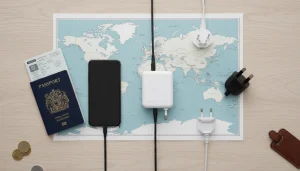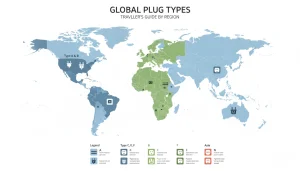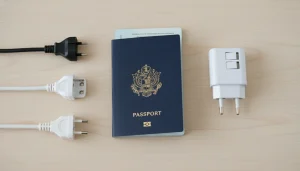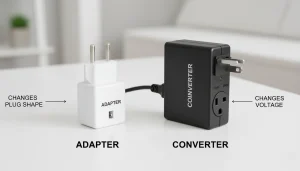
Adapter Types by Country- I’ll never forget the first time I tried to plug my hair straightener into a socket in Paris. I was ready to get photo-perfect for a city stroll — and then, click. Nothing. I looked at the plug, looked at the wall, and realized they were like two puzzle pieces from different boxes.
That was my first crash course in adapter types by country — the unspoken rule of international travel that everyone eventually learns the hard way.
If you’ve ever arrived somewhere and realized your devices are suddenly useless, don’t worry — I’ve been there too. So in this guide, I’m breaking down every plug type, region, and travel trick I’ve learned over the years to keep your devices alive (and your sanity intact).
Quick Look — What You’ll Learn
- The major plug and adapter types used around the world
- Which countries use which types
- Why adapters and converters aren’t the same thing
- Simple travel-tested tips for packing and using adapters
- My personal experiences — and a few funny fails along the way
Why the World Can’t Agree on One Plug Type
Wouldn’t it be amazing if every country just used one universal plug? Imagine the packing freedom! Sadly, when electricity became common in the early 1900s, each country invented its own version.
There was no international standard back then — so every engineer said, “We’ll make our own.” That’s why today we have 15 major plug types (labeled A to N).
Some were made for safety, others for cost or local voltage. None of them were designed for travelers like us.
So now, every time I fly somewhere new, I double-check the plug type before I even book my hotel. And if you’re wondering whether a universal travel adapter can actually fix all that — spoiler: it can help, but not always perfectly.
Plug & Socket Basics (The Easy Way to Understand It)
Before we go country by country, let’s get the basics out of the way.

| Type | Common Regions | Voltage (V) | Plug Style |
| A / B | USA, Canada, Japan, Mexico | 100–127 | Flat parallel pins |
| C / E / F | Most of Europe, South Korea, Indonesia | 220–240 | Round pins |
| G | UK, Ireland, Singapore, Malaysia | 230 | Three rectangular pins |
| I | Australia, New Zealand, China | 230 | Slanted flat blades |
| D / M | India, Nepal, South Africa | 220–240 | Round pins (thick) |
| N | Brazil, South Africa | 230 | Unique three-pin |
Each type has a slightly different pin shape, size, and voltage range.
The voltage matters just as much as the plug. In the U.S., voltage is around 110V, but in Europe, it’s about 230V. That’s why you might also need a converter — not just an adapter — if your gadget isn’t “dual voltage.”
Trust me, nothing ruins a trip faster than watching your electric toothbrush sizzle and die.
Europe: The Continent of Confusing Outlets

Ah, Europe. Beautiful architecture, amazing coffee… and too many plug types.
Most of the continent uses Type C — those two slim round pins. But the UK and Ireland? They had to be different. They use Type G, with three chunky rectangular pins that look like mini Lego blocks.
Here’s a quick cheat sheet:
- France, Germany, Spain, Italy: Type C or F
- Switzerland: Type J
- Denmark: Type K
- UK, Ireland, Malta: Type G
When I backpacked through Europe, I thought one adapter would work everywhere. I was wrong — London taught me humility. I eventually bought a multi-country adapter that could morph between plug shapes like a transformer.
If you’re traveling across Europe and worried about voltage differences, check out Do I need an adapter or converter for Europe — it’ll save you some confusion (and money).
Asia: A Beautiful Chaos of Plug Types
Asia might be my favorite place for food and culture, but it’s also where adapters go to test your patience.
You’ll find Types A, B, C, D, G, and I — sometimes all within one building.
- Japan & Taiwan: Type A (same as the U.S.)
- China: Type I
- India: Type D (large round pins)
- Thailand, Vietnam, Malaysia: A mix of A, B, C, and G
In Bangkok, my hotel’s bedside socket accepted three types of plugs — it was like the United Nations of outlets.
Pro tip: If you’re heading to multiple countries, get a universal adapter with USB ports. It’s lighter and works for most Asian destinations without juggling five adapters.
North America: The Easy Zone
If you’re from the U.S. or Canada, congratulations — you’re already using Type A and B, which cover most of North America.
Mexico, Costa Rica, and parts of Central America also use the same plugs.
The voltage is around 120V, which is convenient for most electronics.
South America, though, is where things get tricky.
- Brazil: Type N (unique and not compatible with A/B)
- Chile & Argentina: Type C
- Peru & Colombia: A mix of A, B, and C
When I went to São Paulo, I had to borrow a local adapter from my Airbnb host because my universal one didn’t fit Type N properly. Lesson: always double-check before flying south.
If your devices aren’t dual voltage, you may want a universal travel adapter with a voltage converter — it protects your devices from overheating.
Australia & Oceania: One Plug Fits Most
Australia and New Zealand both use Type I, and honestly, it’s one of the easiest systems. Two slanted flat blades with a grounding pin.
I once bought an adapter at Sydney Airport, thinking it’d be different in New Zealand — turns out, they use the same one.
If you’re traveling across Oceania (like Fiji or Papua New Guinea), you’ll still be fine with a Type I adapter. Just remember that voltage here is 230V — so make sure your gadgets can handle that.
Middle East & Africa: The Ultimate Mix-and-Match Region
If you ever wanted to see a museum of plug diversity, go to the Middle East or Africa. You’ll find Type C, D, G, and M, often side by side in hotels.
- UAE & Oman: Mostly G
- Egypt: Type C
- Kenya, Nigeria, Ghana: G and D mix
- South Africa: Type M (giant round pins)
When I stayed in Dubai, I was relieved to find both European and UK-style outlets in my room — clearly designed for tourists who forgot adapters.
My go-to choice here is a solid universal travel adapter with built-in surge protection. Some countries have unstable voltage, so the protection helps avoid fried chargers.
If you’re shopping for one, check out what is the best universal travel adapter is — I reviewed several models that can handle regions like these.
Understanding the Adapter vs Converter Confusion
This part’s simple, but important.
- An adapter changes the plug shape.
- A converter changes the electrical voltage.

If your gadget label says “100–240V,” you’re safe with just an adapter.
If it only supports 110V, like many U.S. devices, you’ll need a converter.
I once plugged my curling iron into a 230V socket in Italy — and it emitted a puff of smoke like it was saying goodbye. Since then, I have always read the fine print on my devices.
If you’re ever unsure, here’s a full breakdown:
👉 Do I need a voltage converter for Europe
Travel-Ready Adapter Picks That Actually Work
I’ve tried plenty of adapters — from cheap market ones to fancy branded ones. Here are my top picks that have never failed me:
- Anker PowerPort Cube – doubles as a mini extension cord with multiple ports.
- Ugreen Universal Adapter – lightweight, compact, and includes USB-C.
- Epicka Worldwide Charger – handles 150+ countries with a safety fuse.
- Targus World Power Travel Adapter – sturdy and folds neatly into luggage.
Tip: always buy from a trusted brand. I’ve had budget adapters that sparked, melted, or broke mid-trip — not fun when your only phone charger is stuck inside it.
Smart Adapter Packing Tips (From a Frequent Flyer)
Here’s what experience — and a few airport disasters — taught me:
- Pack two adapters. One for your hotel, one for backup.
- Label them using small colored stickers (e.g., “EU” or “UK”).
- Avoid the cheapest options. They tend to break easily.
- Keep them in a zip pouch so they don’t scratch electronics.
- Bring a mini power strip if you carry a laptop + phone + camera.
- Don’t overload outlets. Most adapters are made for low-power use only.
- Test at home first. It’s easier to fix issues before your trip.
Fun fact: in one Tokyo hostel, I found an entire drawer of forgotten adapters. Travelers leave them behind like souvenirs.
Quick Troubleshooting for Adapter Issues
Sometimes, even with the right plug, things go wrong. Here’s how I handle it:
- Loose fit: Wrap a small rubber band around the plug for grip.
- No power: Try another outlet — sometimes hotel sockets are switched off.
- Sparks or smell: Unplug immediately. Replace the adapter.
- No ground pin: Avoid using heavy electronics like hair dryers.
If your adapter looks cracked or overheated, toss it. They’re cheap to replace, but expensive to regret.
Common Questions I Get from Fellow Travelers
How many adapters should I bring?
At least two. You’ll thank yourself when one goes missing.
Can one universal adapter work worldwide?
Mostly, yes. But older wall sockets can be too tight or recessed.
Do hotels provide adapters?
Some do, but not all. I prefer carrying my own — less waiting at reception.
Can I charge my phone through USB wall sockets?
Yes, but make sure it’s from a trusted source (like hotel rooms, not public spots).
What happens if I use the wrong plug?
It might fit — but if the voltage doesn’t match, your device could short-circuit.
My Real Travel Fails (and What I Learned)
Let’s be honest — no one gets this perfect the first time.
- In Paris: My straightener died. Lesson: always check the voltage.
- In Japan: I forgot my adapter entirely. Ended up borrowing from the reception.
- In London: I had the wrong shape plug for Type G.
- In South Africa: My universal adapter didn’t fit Type M — it was too thick.
Now, I never travel without a spare in my carry-on. Adapters may be tiny, but they can make or break your trip.
My Closing Thoughts

If I could give one travel tip that saves everyone a headache, it’s this: pack the right adapter before you fly.
An adapter might not seem exciting, but it’s the reason your phone charges, your camera works, and your laptop doesn’t die mid-journey.
After years of traveling, I can say this — once you understand adapter types by country, everything gets easier. You pack smarter, you stress less, and you never have to beg strangers at airports for a charger again.
So before your next trip, look up the plug type, toss a good universal adapter in your bag, and enjoy your journey — fully charged.
And if you’re curious about how universal adapters really work, you can read more here:
👉 What is a universal travel adapter
Now my adapter sits permanently in my backpack — right next to my passport and snacks. Because, honestly, nothing says “experienced traveler” like having the right plug the first time.